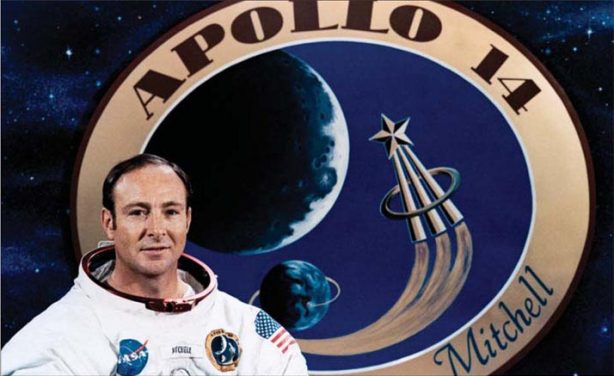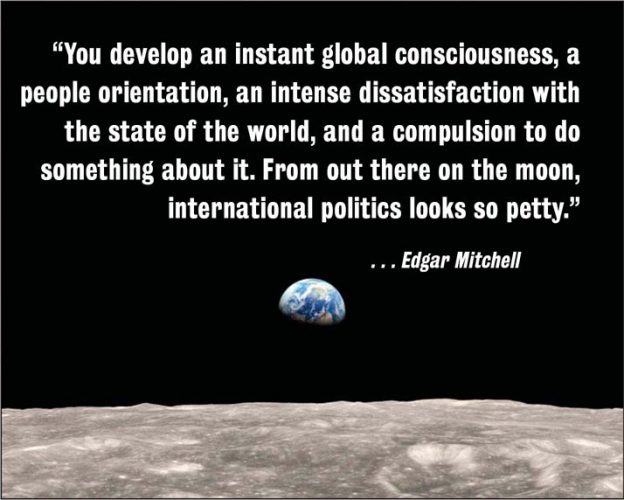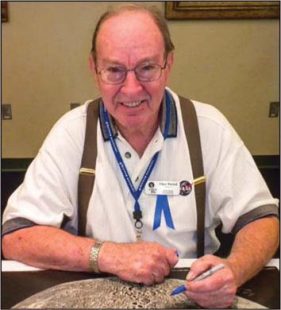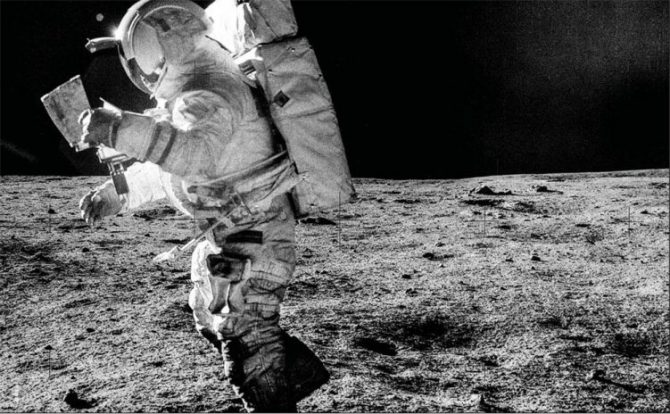How a nine-hour lunar walk and a return to Earth transformed a fighter pilot’s consciousness forever and put him on the path of self-discovery
By Ellen Mahoney
From july 1969 to december 1972 the world watched with anticipation, excitement and sometimes fear as twelve courageous astronauts walked on the moon during six historic Apollo missions.
Going to the moon and walking on the lunar surface took exceptional skill and fortitude for the select moonwalkers. Each astronaut had trained for years with NASA. Many were test pilots, and nearly all were in the military. Being able to fly to the moon, set foot on it, and return home was a profound and even mystical experience for many of these space-faring astronauts. For Apollo 14 astronaut Edgar Mitchell it was life changing.
Mitchell was the Lunar Module Pilot for the Apollo 14 flight, which lasted from January 31, 1971 to February 9, 1971. He traveled to the moon with Commander Alan Shepard and Command Module Pilot Stuart Roosa. Seeing Earth from space, as he sped toward the moon, was a tremendous, life-altering experience for him. In his book Psychic Exploration he wrote, “The first thing that came to mind as I looked at Earth was its incredible beauty. Even the spectacular photographs do not do it justice. It was a majestic sight—a splendid blue and white jewel suspended against a velvet black sky.” Once on the moon, there was much more to absorb. Mitchell and Shepard walked on the lunar surface for nearly nine hours over two days. They completed many science experiments, collected nearly one hundred pounds of moon rocks, and made the longest moonwalk on foot of any Apollo astronaut. Shepard made headlines for hitting an “otherworldly” golf ball up there, but Mitchell’s return home to Earth provided him a transcendent experience that forever transformed him.
Return to Earth
After Mitchell had completed his major tasks on the moon, the ride home was, by contrast, a time of relaxation and reflection. He now had time to sit back in the spacecraft and just peer out the window as a cosmic sightseer—and the view was magnificent. In a 2016 video he said, “I was on the way home and was observing the heavens and the Earth from this distance. (I was) observing the passing of the heavens. As we were rotating, I saw the Earth, the sun, the moon, in a 360-degree panorama of the heavens.”
And because there is no atmosphere in space, Mitchell said everything looked ten times brighter than on Earth. As he stared out the window, an unforgettable feeling of ecstasy and unity washed over him. He felt connected to the stars on a subatomic level with his body, his crew, and even his spacecraft. In his book The Way of the Explorer he wrote, “It occurred to me that the molecules of my body and the molecules of the spacecraft itself were manufactured long ago in the furnace of one of the ancient stars that burned in the heavens about me.” He said every time he looked out the window during that three-day trip back to Earth, he had this incredible, overwhelming feeling of joy.


Moon walk: In his official NASA portrait
What in the World?
Trained as a scientist, with degrees in aeronatics and astronautics, Mitchell felt driven to find out what exactly had happened to him in the spacecraft. The experience had been highly visceral, unlike anything he had ever known, and he wanted to gain an understanding of it. He delved into books and the brains of scientists, looking for insights. When his conversations with scientists didn’t yield satisfying answers, he turned to people in other fields, such as anthropology, spirituality and religion.
Finally, individuals from Rice University in Houston, Texas, told Mitchell about a concept he had never heard of called samadhi, an ancient Sanskrit word describing an intense, heightened state of consciousness, an inner connection with things and a feeling of oneness with the universe. This one word, he felt, best explained his tremendous experience. A few other words, too, helped define what had happened to him: metanoia (a transformative change of heart) and satori (sudden enlightenment). He often said that his experience could be explained as an epiphany, a moment of sudden inspiration or insight.
In a 1993 interview with HINDUISM TODAY magazine, Mitchell offered that his deep-space samadhi could also be likened to the kundalini force, which can sit dormant in the first chakra at the base of the spine until it is awakened. “Yes,” he said, “that’s exactly what I was experiencing, the primordial energy of the universe, the primal and subtlest energies.” Other astronauts, he said, told him they had similar spiritual experiences. He was the only one who really wanted to talk about it.
Whatever it was that had happened to him, Mitchell felt wholly and utterly transformed by that three-day journey home and soon began to make sweeping changes in his life.
A Whole New Life
Completely absorbed in the mind and consciousness as his compelling new frontier, Mitchell had no further interest in the military or the exploration of space. Within about a year of his return from the moon, he retired from a twenty-year career in the Navy—the last six years of that period being with NASA. He has often said he went from “outer space to inner space.” Unfortunately, his fascination with this new exploration impacted his relationship with his wife of 21 years, and she divorced him.
“It occurred to me that the molecules of my body and the molecules of the spacecraft itself were manufactured long ago in the furnace of one of the ancient stars that burned in the heavens about me.”
–Astronaut Mitchell
He started to meditate, and continued the practice for the rest of his life. In the introduction to his book Psychic Exploration he defined meditation in scientific terms: “Studies of yogis, Zen masters, transcendental meditators, and people of other traditions are demonstrating that meditation produces qualitative and beneficial shifts in psycho-physiological condition. Alpha and theta brain waves are two physiological correlates being found for psychological stages of meditation, along with changes in breathing, heartbeat rate, blood pressure, muscle tension, and various other metabolic correlates.” Mitchell would have been concerned about all these metabolic issues as a moonwalker because NASA mission control was constantly monitoring his body as he explored the lunar surface. At one point, while walking more than a mile to the mission destination of Cone Crater, the heart rates of both Mitchell and Shepard soared; the two were told to turn back for their safety and unfortunately they were unable to reach their destination.
In addition to meditating, Mitchell became a peacenik. Though he had spent many years in the military and was a fighter pilot—as was his younger brother, Jay Neely Mitchell, who was serving in the Vietnam War while Edgar was walking on the moon—war and fighting now went against his sensibilities. The beauty and fragility of Earth, as seen from hundreds of thousands of miles away, changed how he felt about our planet. In his memoir, Earthrise, he wrote, “I could see how incredibly beautiful our blue-green Earth looked against the black sky. It was my home. I suddenly felt very protective of Earth and started to see everyone on the planet in a more sacred way.” He felt convinced war was wrong and hoped our politicians and leaders could also see Earth from his deep-space perspective. He believed they would have a new perspective, hopefully a peaceful one.
Mitchell was quoted in an April 8, 1974 People Magazine article: “You develop an instant global consciousness, a people orientation, an intense dissatisfaction with the state of the world, and a compulsion to do something about it. From out there on the moon, international politics looks so petty.”
Other Apollo astronauts have agreed. Apollo 11 astronaut Michael Collins stated in a 2009 NASA interview, “The Earth must become as it appears: blue and white, not capitalist or Communist; blue and white, not rich or poor; blue and white, not envious or envied.”
Mitchell’s moon mission made him more aware of sustainability issues. Growing up on a farm, he understood where food comes from. Although he did not become a vegetarian after his moon mission, Mitchell said he developed an increased awareness of how food is processed and what kinds of foods he consumed. In a 2016 video on sustainability produced by the Eternea research organization, he said, “From space it is obvious that everything on Earth is interconnected. We all breathe the same air, use the same water, and we all share the planet’s resources.”
An Avid Interest in Consciousness
Edgar Mitchell is known for his life work in unraveling questions about the mysteries of life and consciousness. His 1971 samadhi in space triggered an intense drive to investigate consciousness and unexplained issues such as extrasensory perception, telepathy and clairvoyance.
Mitchell’s initial interest in paranormal topics developed during the 1960s, when he became fascinated by the ESP research done by Duke University parapsychologist Dr. Joseph Banks Rhine. The Apollo 14 moon mission gave him a unique opportunity to indulge his scientific curiosity. During his personal time on the spacecraft he conducted four private experiments with four individuals back on Earth, testing whether ESP might bridge up to 240,000 miles of space. Using numbers assigned to the five standard symbols (circle, cross, wavy lines, square, star) of ESP Zener cards, he conducted two tests on the way to the moon and two tests on the way back. The four individuals on Earth were to try to write down the symbols in the same order Mitchell thought about them.


Landing at sea: Navy divers assist the three Apollo 14 astronauts out of their Command Module moments after it fell into the Pacific Ocean on February 9, 1971;
Back on Earth, the results of these deep-space ESP experiments were analyzed by Dr. J.B. Rhine, parapsychologist Dr. Karlis Osis of the American Society of Psychical Research, and by Mitchell himself. He said the data was difficult to evaluate because lift-off from Earth had been delayed, affecting the timing of the tests. In Psychic Exploration he wrote, “The results were statistically significant … because the number of hits was amazingly low. The statistical probability of scoring so few hits was about 3000:1.” He explained that this negative ESP effect was called psi-missing, which in itself offered evidence for the power of psi (psychic phenomena): the striking difference from chance results showed that something was happening, even though the effect was not what was expected. In Way of the Explorer Mitchell wrote, “The results of our in-flight effort suggested that there was some kind of communication being achieved during the experiment that wasn’t through the conduit of conventional transmission.” A report of his findings, “An ESP Test from Apollo 14,” was published in the June, 1971, issue of the Journal of Parapsychology.
“An invisible and subtle essence is the Spirit of the whole universe. That is Reality. That is Truth. Thou art That.”
–Upanishads
Mitchell’s research into consciousness took him around the planet, searching for answers from all sorts of people including shamans, psychics, and spiritual healers. Along with changes in his lifetime, his circle of friends and colleagues was changing.
In 1972 he met two unique individuals, American healer Norbu Chen and Israeli psychic Uri Geller. Chen had studied Tibetan Buddhism and ancient shamanistic practices. At one point Chen tried to help Mitchell’s mother, Ollidean, with her failing eyesight. Mitchell said his mother’s eyesight was corrected at first but then reverted back. Geller is best known for being able to bend a metal spoon with his mind. His psychic abilities were studied at the Stanford Research Institute in Palo Alto, California, in the early 1970s. Mitchell was fascinated by Chen and Geller (whose abilities and claims were criticized as well as applauded) and wrote about both individuals in his books Psychic Exploration and Way of the Explorer.
In 1973 Mitchell founded the Institute of Noetic Sciences (IONS) to further research the fundamentals of consciousness. Noetic comes from the ancient Greek term nous, which is best translated as “inner knowing” or “intuitive consciousness.” The IONS website (www.noetic.org) describes Noetic Sciences as “A multidisciplinary field that brings objective scientific tools and techniques together with subjective inner knowing to study the full range of human experiences.” Since its founding, IONS has focused on key subjects such as mind-body interactions and the intersection of science with spiritual experience. Today IONS is located in Petaluma, California. Its current areas of research include consciousness and healing, extended human capacities, and worldview transformations.


Landing at sea: Mitchell mapping his historic 33 hours on the moon.


Ellen Mahoney is a professor of journalism at the University of Colorado, Boulder. She helped Dr. Edgar Mitchell write Earthrise—My Adventures as an Apollo 14 Astronaut. She is the author of Gandhi for Kids. Contact: evm@infionline.net
We Are Not Alone
Edgar Mitchell is widely known for his outspoken views about extraterrestrials and his belief that we are not alone in the universe. He discussed these concepts on radio and television shows, in Internet videos, and in speeches and books, remarking that he and the other eleven Apollo moonwalkers were, in fact, extraterrestrials from Earth visiting a different heavenly body.
The seed for his interest in UFOs and extraterrestrials was planted early. He grew up in Roswell, New Mexico, and the nearby city of Artesia. On July 8, 1947, he opened the Roswell Daily Record to find a headline in big bold letters: “RAAF Captures Flying Saucer on Ranch in Roswell Region.” (RAAF was the Roswell Army Air Field.) The story captured the boy’s attention, and he wondered if a UFO had truly crashed. But the next day the newspaper came out with a new story, saying the crashed “UFO” had actually been a crashed weather balloon. He seemed to accept this explanation at the time, focused on preparing to start college in the fall at the Carnegie Institute of Technology in Pittsburgh, Pennsylvania.
Increasing Scientific Interest
Though many people accept and are open to the ideas that Mitchell put forth about life in the universe beyond Earth, he has sometimes been ridiculed for his beliefs. Mitchell never deviated, however, from what he believed to be true. Today, with large space telescopes helping us see how incredibly vast the cosmos is and finding more and more Earth-like planets, more and more people are open to the idea that we are not alone in the universe.
Science and math are integral in this exploration. Many scientists use the widely known Drake Equation to evaluate the possibility of life in space. Written in 1961 by Harvard astronomer Dr. Frank D. Drake and often cited by famous astronomer and astrophysicist Carl Sagan, this equation is a method for estimating the number of possible extraterrestrial civilizations in the Milky Way galaxy. It has inspired scientists to explore the possibility of sentient life beyond Earth.
Dr. Drake has also been a key figure in the SETI Institute (an acronym for the Search for Extraterrestrial Intelligence), which was founded in 1984 in California. The SETI Institute explores the origin and nature of life in the universe and is sponsored by a number of organizations such as NASA, the National Science Foundation and the Jet Propulsion Laboratory. Seth Shostak, a senior astronomer for SETI, believes we will find ET life in the not-too-distant future. And in a 2014 Tyson Series video, “Are We Alone in the Universe?” astrophysicist Dr. Neil de-Grasse Tyson said, “It would be inexcusably egocentric to suggest that we are alone in the cosmos. The chemistry is too rich to declare that. The universe—too vast.”
A Visionary
Edgar Mitchell was a unique space explorer who came from a family of pioneers. In a matter of only one hundred years, his great grandparents crossed the US after the Civil War in covered wagons in search of a better life out west, his father was born when the Wright brothers made their first flight—and he walked on the moon. He was and continues to be a visionary for this planet, shining an important light on the great mysteries of consciousness and the cosmos. In Psychic Exploration he expressed his wishes for our planet: “Humanity must rise from man to mankind, from the personal to the transpersonal, from self-consciousness to cosmic consciousness.” It’s exciting to know there is so much yet to explore and understand.


